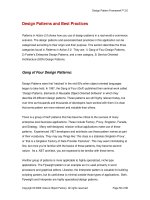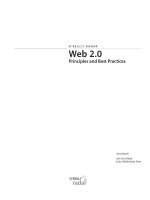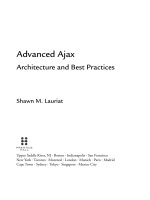prentice hall advanced ajax, architecture and best practices (2008)
Bạn đang xem bản rút gọn của tài liệu. Xem và tải ngay bản đầy đủ của tài liệu tại đây (2.61 MB, 363 trang )
Advanced Ajax
Architecture and Best Practices
Shawn M. Lauriat
Upper Saddle River, NJ • Boston • Indianapolis • San Francisco
New York
• Toronto • Montreal • London • Munich • Paris • Madrid
Cape Town
• Sydney • Tokyo • Singapore • Mexico City
Many of the designations used by manufacturers and sellers to distinguish their products are
claimed as trademarks. Where those designations appear in this book, and the publisher was
aware of a trademark claim, the designations have been printed with initial capital letters or in
all capitals.
The author and publisher have taken care in the preparation of this book, but make no expressed
or implied warranty of any kind and assume no responsibility for errors or omissions. No liability
is assumed for incidental or consequential damages in connection with or arising out of the use of
the information or programs contained herein.
The publisher offers excellent discounts on this book when ordered in quantity for bulk purchases
or special sales, which may include electronic versions and/or custom covers and content particu-
lar to your business, training goals, marketing focus, and branding interests. For more informa-
tion, please contact:
U.S. Corporate and Government Sales
(800) 382-3419
For sales outside the United States, please contact:
International Sales
V
isit us on the Web: www.informit.com/title/9780131350649
Library of Congress Cataloging-in-Publication Data:
Lauriat, Shawn M.
Advanced Ajax : architecture and best practices / Shawn M. Lauriat.
p. cm.
ISBN 0-13-135064-1 (pbk. : alk. paper) 1. Ajax (Web site development technology) I. Title.
TK5105.8885.A52L38 2007
006.7 dc22
2007030306
Copyright © 2008 Pearson Education, Inc.
All rights reserved. Printed in the United States of America. This publication is protected by copyright, and permission must be
obtained from the publisher prior to any prohibited reproduction, storage in a retrieval system, or transmission in any form or by
any means, electronic, mechanical, photocopying, recording, or likewise. For information regarding permissions, write to:
Pearson Education, Inc.
Rights and Contracts Department
75 Arlington Street, Suite 300
Boston, MA 02116
Fax: (617) 848-7047
ISBN-13: 978-0-13-135064-9
ISBN-10: 0-13-135064-1
Text printed in the United States on recycled paper at Courier Stoughton in Stoughton, Massachusetts.
First printing October 2007
Editor-in-Chief
Mark Taub
Acquisitions Editor
Debra Williams Cauley
Development Editor
Michael Thurston
Managing Editor
Gina Kanouse
Project Editor
Anne Goebel
Copy Editor
Jill Batistick
Indexer
Erika Millen
Proofreader
Water Crest Publishing
Technical Reviewers
Jason Ellis
Eric Foster-Johnson
Chris Shifl ett
Publishing Coordinator
Heather Fox
Cover Designer
Gary Adair
Composition
codeMantra
vii
Contents
Acknowledgments xiii
About the Author xv
Introduction 1
0.1 Ajax, the Acronym 2
0.1.1 Asynchronous 3
0.1.2 JavaScript 3
0.1.3 XML 4
0.2 This Book’s Intentions 5
0.3 Prerequisites for This Book 8
Chapter 1 Usability 11
1.1 Interface Versus Showcase 12
1.1.1 Implementation 14
1.2 User Expectations 16
1.3 Indicators and Other Forms of User Feedback 17
1.3.1 The Throbber 17
1.3.2 Progress Indicators 20
1.3.3 Keeping the User in the Loop 22
1.4 Semantic Markup 30
1.4.1 More Accessible 30
1.4.2 Easier to Use 32
viii Contents
1.4.3 Easier to Maintain 33
1.4.4 Easier to Parse 34
1.5 What CSS and JavaScript Have in Common 37
Chapter 2 Accessibility 43
2.1 WCAG and Section 508 44
2.1.1 WCAG 45
2.1.2 Section 508 51
2.2 Screen Readers Can Handle Ajax 53
2.2.1 Content Replacement 54
2.2.2 Form Validation 55
2.3 Unobtrusive Ajax 56
2.4 Designing with Accessibility in Mind 58
2.4.1 High-Contrast Design 59
2.4.2 Zoomable Interface 60
2.4.3 Easily Targeted Controls 62
2.5 WAI-ARIA 63
Chapter 3 Client-Side Application Architecture 67
3.1 Objects and Event Triggering 68
3.1.1 Native Object Event Handling 70
3.1.2 JavaScript Objects 71
3.2 Model-View-Controller Design Pattern 87
3.2.1 The Model 88
3.2.2 The View 92
3.2.3 The Controller 101
3.3 Event-Driven Application Development 104
3.3.1 Advantages of Architecture 104
Contents ix
Chapter 4 Debugging Client-Side Code 107
4.1 Validation, Validation, Validation 108
4.1.1 Markup Validator 109
4.1.2 CSS Validator 110
4.1.3 Semantic Extractor 111
4.2 Browser Tools and Plugins 111
4.2.1 The Console 112
4.2.2 Internet Explorer 113
4.2.3 Firefox 116
4.2.4 Opera 122
4.2.5 Safari 124
4.3 JavaScript Profiling 126
4.3.1 Recognizing Bottlenecks 128
4.4 Unit Testing 132
4.4.1 Assertions 134
4.4.2 Test Setup 135
4.4.3 The Test Itself 137
4.4.4 Mock Objects 140
4.4.5 Test Suites 143
Chapter 5 Performance Optimization 145
5.1 Database Performance 146
5.1.1 Schema 146
5.1.2 Queries 150
5.2 Bandwidth and Latency 154
5.2.1 Bandwidth 154
5.2.2 Latency 158
x Contents
5.3 Cache 160
5.3.1 Filesystem 161
5.3.2 Memory 163
5.3.3 Completing the Implementation 170
5.4 Taking Advantage of HTTP/1.1 171
5.4.1 If-Modified-Since 174
5.4.2 Range 176
5.5 PHP Profiling 178
5.5.1 Advanced PHP Debugger 179
5.5.2 Xdebug 182
Chapter 6 Scalable, Maintainable Ajax 187
6.1 General Practices 188
6.1.1 Processor Usage 188
6.1.2 Memory Usage 191
6.2 A Multitude of Simple Interfaces 194
6.2.1 Modularity 195
6.2.2 Late Loading 198
6.3 Dense, Rich Interfaces 201
6.3.1 Monolithic Applications 201
6.3.2 Preloading 204
Chapter 7 Server-Side Application Architecture 207
7.1 Designing Applications for Multiple Interfaces 208
7.2 Model-View-Controller Design Pattern 212
7.2.1 The Model 212
7.2.2 The Controller 222
7.2.3 The View 231
7.3 Using the Factory Pattern with Your Template Engine 237
Contents xi
Chapter 8 Keeping a Web Application Secure 243
8.1 HTTPS 244
8.1.1 Why Use HTTPS? 245
8.1.2 Security Versus Performance 247
8.2 SQL Injection 247
8.2.1 Don’t Use Magic Quotes 248
8.2.2 Filtering 249
8.2.3 Prepared Statements 251
8.3 XSS 252
8.3.1 Escaping for Markup 252
8.3.2 Escaping for URLs 257
8.4 CSRF 258
8.4.1 Check the Referer 259
8.4.2 Submit an Additional Header 261
8.4.3 Secondary, Random Tokens 262
8.5 Don’t Trust the User 265
8.6 Don’t Trust the Server 266
Chapter 9 Documenting 271
9.1 Yes, You Need to Document 272
9.1.1 Jog Your Own Memory 272
9.1.2 Lessen the Learning Curve 274
9.1.3 Mind That Bus 274
9.2 API Documentation 275
9.2.1 phpDocumentor 275
9.2.2 JSDoc 283
9.3 Internal Developer Documentation 288
9.3.1 Coding Standards 289
xii Contents
9.3.2 Programming Guides 293
9.3.3 Style Guides 295
Chapter 10 Game Development 297
10.1 A Different Kind of Security 299
10.1.1 Validation 300
10.1.2 Server-Side Logic 302
10.2 Single Player 304
10.2.1 Double Buffering with Canvas 305
10.3 “Real-Time” Multiplayer 310
10.3.1 Streaming Response 310
10.3.2 WHATWG event-source Element 315
10.3.3 Predictive Animation 317
Chapter 11 Conclusions 321
11.1 Remember the Users 322
11.2 Design for the Future 323
11.3 Develop for the Future 324
Bibliography 325
Appendix A Resources 329
Appendix A OpenAjax 333
Conformance 334
Namespace Registration 337
Event Management 338
Index 341
xiii
Acknowledgments
Several people took time out of their schedules to answer my questions while
researching various parts of this book, and they helped immensely.
Terry Chay not only engaged me in some fantastic discussions on real-world Ajax
development and how to make the book easier to read, but also introduced me around
to several of the other speakers at the 2006 Zend Conference. I greatly value the input
from someone who has no qualms about calling “bullshit” often, loudly, accurately,
and then immediately explaining it for you.
Despite his full schedule at the Zend Conference, Chris Shifl ett agreed to meet for
breakfast to talk about a book on Ajax. As a specialist in PHP and web application
security, his questions and comments helped keep the focus of the security chapter in
this book on some of the primary issues Ajax developers face today.
Zend Technologies, Ltd. helped me attend the Zend/PHP Conference & Expo
2006 and arranged for a very informative phone conversation with Andi Gutmans
afterward. Though also not an Ajax developer, Andi brought several issues to the table
as a developer often working on server-side applications of Ajax-driven sites.
Jon Ferraiolo leads the OpenAjax Alliance and has no small task ahead of him
in boiling the opinions and intentions of dozens of companies into tangible, useful
tools for Ajax developers. He answered my questions about the Alliance and about the
OpenAjax Hub, greatly helping to clarify the meaning of the Hub specifi cation and
the direction of the Alliance.
Two friends closer to home helped give support in the areas they knew best. Rev. Molly
Black, D.D., helped when I needed the advice of a trained journalist for wording issues
I ran into, and when I needed someone with a designer’s eye to help pick an appealing
cover that stayed with the feel of the book. Jason Ellis, a coworker and friend, seemed
almost as excited as I felt when I fi rst got the book deal, and he helped read chapters
and code all the way through, making sure I kept things on track, clear to the reader,
thorough, and accurate.
I defi nitely need to thank my agent, David Fugate, for fi nding me on Linkedin.com
and offering the chance to write a book to someone who hadn’t written anything since
school, and Debra Williams Cauley, Executive Editor at Prentice Hall. Debra worked
closely with me from start to fi nish to help navigate the process surrounding the writ-
ing itself, pulling in people from all over to look over chapters, and give criticisms and
suggestions.
And for general inspiration, especially when trying to come up with interesting
code samples: Edgar Allan Poe, P.G. Wodehouse, Roald Dahl, Douglas Adams, Wade
VanLandingham, Tank Girl, Mae West, Arnold Judas Rimmer BSc. SSc., Groucho
Marx, Morgiana, Jack D. Ripper, Forbidden Zone, Vyvyan Basterd, Professor
Hubert J. Farnsworth, and others who have slipped my mind at the moment.
xiv Acknowledgments
xv
About the Author
Shawn M. Lauriat moved to San Francisco during the heady heyday of the dot.com boom.
After learning his lesson the hard way (as did many other developers), his family moved to
Long Beach for a year of schooling and some contract work. Upon their return to SF,
he got a contract job for the EPA and his career slowly built up from there.
Between doing contract work for his own company, Frozen O, and others, he
learned a lot on his own and started teaching himself the newest of the web application
technologies. When his family moved to Austin for the weather, tech industry, and
low cost of living, a funny thing happened: His skills became very much a welcome
commodity, and he has been fending off companies ever since. He currently leads
development on the Ajax-driven web application for the most powerful build/process
automation tool in the industry, IBM Rational Build Forge.
This book is his fi rst book and probably not his last, but he has some work to do
making music, working on his own web projects, acting as a photographer’s assistant
for his disabled wife, and playing with their two dogs and three cats. Then he’ll have
permission to write another.
1
Introduction
In This Chapter
Q 0.1 Ajax, the Acronym 2
Q 0.2 This Book’s Intentions 5
Q 0.3 Prerequisites for This Book 8
2
A
s the centerpiece of rich web application development, Ajax brings web
interfaces using XHTML and CSS up to desktop application interface
standards without the interfaces having to rely on plugins such as Flash or Java.
Prior to JavaScript-based server interactions, interfaces had to rely solely on full-
page loading, regardless of how one might have hacked a page into appearing
otherwise.
Until Ajax development came along (which, incidentally, started in imple-
mentation many years before the coining of the term itself), client-side
development also had no thread support. Threading, in a nutshell, allows
the spawning of new lines of logic, completely independent of those before,
adjacent to, or after it. C, Java, Perl, and many other languages have had this
support for many years (in some cases) before client-side scripting came along
in any fashionable sense. The closest JavaScript had to offer came in the form
of the
setTimeout and setInterval library functions, which required delayed,
seemingly parallel execution rather than the actual spawning of processes.
While Ajax still does not provide true threading, it does bring JavaScript one
step closer.
0.1 Ajax, the Acronym
The words Asynchronous Javascript And XML make the acronym Ajax. In order
to fully understand Ajax in meaning and implementation, you must understand
each of its components. Even when using synchronous requests, or using JSON or
some other transportation method, knowing the core aspects of Ajax can only help
development practices.
Since the initial boom in popularity and resulting hype surrounding Ajax, it
can get quite easy to forget what Ajax actually means and what it doesn’t. Ajax
does exist as an incredibly useful method of communicating with the server
directly from JavaScript. It does not mean anything more than that, even if its us-
age can open up development methods previously unexplored in web application
development.
3
0.1.1 Asynchronous
When requests get submitted to the server, they have no direct impact on any other
simultaneous or subsequential requests. In other words, just because a request gets
submitted before another request does not in any way ensure that it will receive its
response from the server fi rst. Despite the seemingly simplistic concept, asynchronistic
behavior in applications often gets ignored, because asynchronicity introduces an en-
tirely new level of complexity to client-side development.
Many Ajax-based web applications use the asynchronous fl ag of the
XMLHttpRequest
object solely to handle network errors (sometime without even intending to do so)
rather than to keep functionality enabled during a given request. While the direct
JavaScript-to-server communication provided by the
XMLHttpRequest forms the core
of the technology, the asynchronous behavior it also can provide often plays the part
of the unsung hero, as it brings a wealth of fl exibility and strength to client-side web
applications .
0.1.2 JavaScript
JavaScript (based on ECMAScript,
1
though possibly vice-versa depending on whom
you ask) has many implementations, not only in various web browsers, but also in
game development and other applications needing an easy-to-learn scripting language.
This book focuses on the implementation of JavaScript in various web browsers. These
impleMentations of JavaScript have a wide variety of incompatibilities, from Mozilla’s
SpiderMonkey
2
to Safari’s WebKit to Jscript and more.
Those used to server-side development or OOP (Object-Oriented Programming)
may initially get thrown off by JavaScript’s prototype-based object model. This, in a
very basic sense, means that functions and methods called within a certain object get
called in the context of that object. This happens because rather than an instance having
1
Ecma International , an industry association devoted to standardizing “Information and Communication Technology
(ICT) and Consumer Electronics (CE)” (What is Ecma International, www.ecma-international.org/memento/index.html),
maintains the ECMA-262 standard (www.ecma-international.org/publications/standards/Ecma-262.html) which defi nes the
scripting language of ECMAScript.
2
Gecko rendering engine’s JavaScript engine written in C is used by
Mozilla-based browsers such as Firefox (www.mozilla.com/products/fi refox), SeaMonkey (www.mozilla.org/projects/seamonkey),
Camino (www.caminobrowser.org), and Epiphany (www.gnome.org/projects/epiphany).
Ajax, the Acronym
an explicit tie to its defi nition, its prototype merely lays out the basis for its structure
and characteristics.
The JavaScript object,
XMLHttpRequest (originally an ActiveX control created by
Microsoft), provides the key to the entire technology conglomeration now referred to
as Ajax. It provides an interface by which JavaScript can send and receive data to and
from the server without requiring a full page load. Other methods exist for sending
and receiving data, but they each use aspects of HTML and XHTML in ways other
than designed, and, as such (while still useful in certain circumstances), they exist only
as hacks .
0.1.3 XML
XML stands for eXtensible Markup Language, as defi ned by the World Wide Web Con-
sortium (W3C; ), and provides a very fl exible, generic text format. If
that seems to be a rather broad description, it should be. XML now uses spanning
data storage, communication, defi nition, description, and presentation. In Ajax, XML
refers to data transportation. The
XMLHttpRequest object provides another useful bit
of functionality along with its HTTP methods: When the server returns XML, the
XMLHttpRequest object provides the responseXML attribute, which is a read-only XML
document of the response.
Using XML, a very simple response from the server, with two named variables
(
var1 and var2) each set to string values ("first value" and "second value," respectively),
might look like the following:
<?xml version="1.0"?>
<response>
<var1>first value</var1>
<var2>second value</var2>
</response>
Many Ajax-driven web applications use other formats of transporting data to and
from the server, including:
Q URL-encoded—Where data takes the form used by HTTP POST requests, as
during a form submission such as
var1=first%20value&var2=second%20value.
Q
Raw text—Usually for very simple data, or when responses return the exact
markup for the JavaScript to insert into the current document:
4 Introduction
5
<input type="text" name="var1" value="first value" />
<input type="text" name="var2" value="second value" />
Q
JavaScript Object Notation (JSON)—An increasingly popular format, JSON
formats data into a subset of raw JavaScript. This not only has the advantage of
instant parsing by client-side code, but also it tends to take up less bandwidth
than more verbose, globally understood formats such as XML. In addition, it
does so without losing the data structure as URL-encoded value pairs do :
{
var1:"first value",
var2:"second value"
}
0.2 This Book’s Intentions
Now that the technology has progressed into general usage, the Ajax developer com-
munity has a need for books covering architecture, tuning, alternative uses of Ajax,
and more. Many books and tutorials have provided good introductions, and they can
show you several different ways of implementing fi nd-as-you-type, chat widgets, and
RSS/ATOM feed readers. Many of the resources out there explain, in great detail, the
history of Ajax and its multiple incarnations before today’s and the implementation
centered on the
XMLHttpRequest JavaScript object. See Appendix A, “Resources,” at the
end of this book for some choice suggestions.
This book, instead, looks at using Ajax to create rich, browser-based interfaces for
enterprise-level web applications, taking into account the fl exibility, reusability, scal-
ability, and maintainability necessary for such an undertaking. Ajax does not exist in
this book as the latest and greatest acronym to hit web development. It instead exists as
a tool like any other—extremely useful in some instances and totally wrong in others.
For example, many reference sites would fi nd themselves hard-pressed to use Ajax
for anything of particular value to their users. Manuals and other reference materials
that have large blocks of text for the user to read might come up with an Ajax reader,
allowing a single, scrollable pane that late-loads content as the user scrolls though it.
This sounds cool, but it destroys the ability to search the page for a particular word
or phrase. It also removes the ability to read something once you’ve lost your Internet
connection. Some reference sites add auto-suggestions to their search fi elds, but those
tend to react too slowly for general usage unless you pre-load the entire dictionary into
This Book’s Intentions
6 Introduction
the browser’s memory, potentially wasting a great deal of bandwidth for a feature that
only a few people might enjoy having at their disposal.
craigslist.org (see Figure 0.1) is a good example of a site that fl ourishes without a
fl ashy or cluttered interface, and it has grown to provide largely free classifi ed services and
forums to 450 cities in 50 countries without so much as a single image on their main
page, let alone rich application functionality. The site instead focuses on content and
searching that content.
By contrast, sites and web applications dealing with rapid browsing and editing of
a large number of smaller items, or a large number of small, editable chunks of large
items, fl ourish with Ajax usage. Google Maps (see Figure 0.2) brought everybody’s
attention to Ajax when it went public beta, and it uses Ajax to bring in a large number
of images and metadata in chunks according to the user’s interactions with the map.
Web applications having a large number of transactions for a given set of elements,
online games for example, save a lot of time and bandwidth by reusing the same inter-
face multiple times to submit and display similar data.
FIGURE 0.1 The default craigslist.org page.
7
No matter what your project, you should know the options for reaching your goals,
which options work the best, and why. Ajax has a lot of buzz around it, both positive
and negative; what it really needs, instead, is a good, solid foundation for serious, real-
world application development. The OpenAjax Alliance
3
has started moving in this
direction, building tools to prevent name collisions between Ajax toolkits and bring-
ing companies and individuals together in an effort to promote stability, security, and
interoperability between professional-grade toolkits.
This book covers the range of topics necessary to create a well-rounded application,
regardless of the tools and technologies used. Many developers have created their own
toolkits in order to abstract the actual Ajax communication layers and to speed develop-
ment. Though none of the material here targets any particular toolkit, you easily could use
many of those in development while still following each of the chapters.
3
“The OpenAjax Alliance is an organization of leading vendors, open source projects, and companies using Ajax that are dedi-
cated to the successful adoption of open and interoperable Ajax-based Web technologies. The prime objective is to accelerate
customer success with Ajax by promoting a customer’s ability to mix and match solutions from Ajax technology providers and
by helping to drive the future of the Ajax ecosystem” (www.openajax.org).
FIGURE 0.2 Google Maps focusing on Austin, TX.
This Book’s Intentions
8 Introduction
0.3 Prerequisites for This Book
Other Ajax books have spent so much time introducing the reader to all of the tech-
nologies involved (Apache, MySQL, PHP, XHTML, JavaScript, and of course the
XMLHttpRequest object itself) that they have not had the opportunity to delve into more
advanced topics and practices. This book takes advantage of what already has been
written to assume a certain level of understanding, in order to examine and explore in
detail the more intricate methods of designing a web application to use Ajax. Instead
of looking at some of the available AJAX frameworks, this book takes a brief look at
the more experimental uses, such as game development.
As such, if you have not already worked with Ajax or some form of server-side
scripting language, database, or web server, you should probably read a book like
Understanding Ajax (Eichorn, 2006), following along with the examples. While this
Introduction establishes the technologies used and referenced later in the book, it does
so only as a quick overview, just as a professor provides a quick overview during the fi rst
week of a semester to refresh your memory of last semester’s course.
The example code in this book uses the following technologies for each application
layer. You should have a general understanding of all of these before you begin reading
this book:
Q Webserver—Apache’s HTTPD () version 2.0. As of
this writing, the Apache foundation has released the 2.2.* branch as the pri-
mary stable branch. The example configuration directives in the book should
carry over to the newer version without much deviation.
Q Database Server— MySQL Database Server 5.0 ( />downloads/mysql/5.0.html). The 5.0.* branch introduces a wealth of useful
functionality and stability over previous versions, including stored procedures,
triggers, views, and strict mode. As of this writing, MySQL AB has released the
5.1 branch as a beta.
Q Server-Side Scripting— PHP 5.2 (www.php.net/releases/5_2_0.php).
PHP 5.2 brings an input filtering extension, a JSON library enabled by default,
greater ability to track file upload progress, vastly improved time zone handling,
and more. While PHP 6 brings global Unicode support to PHP,
4
along with
4
PHP does not technically pay attention to the bytes of strings. It just regards them as a numbered list of bytes. While this has
the benefi t of passing UTF-8 strings through PHP (even without the Multi-byte String library) unharmed, side effects can
show themselves in the strangest, often most devastating, places in your application.
9
cleaned-up functionality, closer integration of the new PDO database extensions,
even more drastic improvements to the object model, and, for some reason,
goto (in the form of named break statements), the PHP group has made it avail-
able only from source so far. It has much development left on it, but should see
greater adoption rates than PHP5 has seen so far.
Q Markup— XHTML 1.1 (www.w3.org/TR/xhtml11). While XHTML 2.0 has
reached its eighth public working draft, XHTML 1.1 maintains HTML compat-
ibility while strictly enforcing XML, modules, and the progression to XHTML
2.0. Unfortunately, Internet Explorer does not really support XHTML; rather, it
renders it as HTML. This does make quite a difference and holds many developers
back from fully embracing the XHTML modules available to them. As such,
the markup directly rendered in the browser will have
Content-type: text/html
rather than application/xhtml+xml, as recommended by the W3C. Technically, the
specification (www.w3.org/TR/xhtml-media-types) strongly recommends against
using
text/html with anything beyond HTML 4 or XHTML 1.0 (HTML
compatible). However, it does not forbid it, as it does with the practice of using
anything aside from
text/html with HTML 4.
Q Style— CSS 2.1 (Cascading Style Sheets, level 2 revision 1, www.w3.org/TR/
CSS21). CSS 3 introduces much of the styling and layout abilities asked for
years ago and eagerly awaited by web designers; however, it has not reached a
stable enough point for many of the browsers to support any more than some
of the basics.
5
Even with the much-anticipated release of Internet Explorer 7
(hereafter referred to as IE or IE7), IE still fails to completely support even the
CSS 2.0 specification. The IE development team worked very hard to improve
the state of IE’s CSS support and, while they did a fantastic job, they didn’t
quite make it all the way there. Because many resources (http://css-discuss.
incutio.com, and many more) exist to cover the
hacks and fixes necessary to force IE6 and IE7 to follow your design, this book
will not go into detail of how to achieve complete, pixel-perfect, cross-browser
designs.
Q Client-Side Scripting—This book will use JavaScript 1.5, together with the
XMLHttpRequest object, which currently exists only as an informally agreed
5
Rounded borders, multiple background images, column layout, text shadows, and transparency have all made it into the Webkit
project. As of this writing, the Mozilla Gecko engine and Opera’s rendering engine both have implemented most of these.
Prerequisites for This Book
10 Introduction
upon object and the very beginnings of a specification (www.w3.org/TR/
XMLHttpRequest as part of the Web API Working Group’s activities). Many
Ajax-type web applications and sites use Adobe Flash for text and XML com-
munication with the server; however, Flash development gets too specific for
coverage in this book. Many of the same principles and much of the architec-
ture covered still apply, but the implementation differs. ActionScript, also an
ECMAScript implementation, actually shares the syntax, object model, and
often even its development tools with JavaScript, so while the
XMLHttpRequest
object does not exist in ActionScript, and the working DOM differs, much of
the other sample code should look very familiar and easy to follow.
Familiarity, at least to the point of understanding enough to port the code into
your language of choice, will defi nitely help, though this book aims to provide the
methodologies, architectures, and patterns that you can implement in your own rich
web application, no matter what technology you use to drive it. The technologies listed
previously have several benefi ts. The organizations behind them have made them freely
available for download and use on a wide range of platforms and have tested them in a
wide range of browsers. In addition, the technologies have large user bases and online
communities ready and willing to assist you if you run into any problems.
11
1
Usability
In This Chapter
Q 1.1 Interface Versus Showcase 12
Q 1.2 User Expectations 16
Q 1.3 Indicators and Other Forms of User Feedback 17
Q 1.4 Semantic Markup 30
Q 1.5 What CSS and JavaScript Have in Common 37
12
E
dgar Allan Poe once said that, in short stories, every word of every sentence
needs to contribute to the piece as a whole. Anything else wastes the page’s
space and the readers’ time and should get cut.
When it comes to user interfaces, this philosophy also applies to everything on the
page, whether it be text, a form element, or a piece of media. People tend to overdo
their use of newly adopted technologies, and Ajax is no exception. Ajax usage has
exploded, much like the web technologies, which include the
blink and marquee
HTML tags,
1
animated GIFs, applets, the table HTML tag, and Flash.
Most web designers and developers have reflexively negative reactions upon the
mention of these after their initial popularity gave way to overusage. All of these
technologies had an original, utilitarian purpose, which now is overshadowed by
the notion that they bring no benefit to the user; the only exceptions to this rule
might be the
blink and marquee tags, which actually have specific instructions
against their usage written up by the W3C .
1.1 Interface Versus Showcase
Ajax-based functionality fi ts best where it makes a given task easier for the user,
rather than just replicating functionality easily achieved by simpler, faster-developed
means. Using half a dozen JavaScript fi les, numerous CSS fi les, and several Ajax calls
just to render a company home page uses a lot of time and memory for very little
benefi t to the user.
2
It actually makes the user wait much longer than necessary while
using much more of your server resources than necessary.
Figure 1.1 shows a screenshot of Firebug, which is a CSS, DOM, and JavaScript
debugging tool for Firefox (see Chapter 4, “Debugging Client-Side Code,” for more
information on this Firefox extension). The screenshot shows the loading time and
order for all linked resources from an example of a particularly excessive corporate
web site’s default page. The page includes 18 Ajax calls, 14 style sheets, 8 JavaScript
1
Neither of these tags actually exists within the HTML specifi cation, but browsers have supported them for years, regardless.
2
This does not mean that the referenced technology does not ever have benefi t to the user, just that this particular use case
does not benefi t the user enough to warrant its usage.
13
fi les, and the usual listing of linked image resources. This page took a total of 5.02
seconds to load over a business cable connection, with a total page weight of 627kB.
FIGURE 1.1 Firebug’s resource-loading profi le of a corporate site’s default page.
In contrast to this Ajax overusage, adding a light-weight content-loading script that
displays a blog’s comments when requested by the user reduces loading time by using
less bandwidth; in addition, it keeps the comments in a context that is better than
jumping to a comment page with (in some cases) drastically different design.
Interface Versus Showcase
14 Chapter 1 Usability
1.1.1 Implementation
Figure 1.2 shows a user registration interface in which the users follow three steps in order
to create their account. The numbered, tabbed interface makes it clear to the users how
long of a process they have altogether, how far they’ve progressed, and how far they still
have to go. The encapsulation of the form inside a tab’s container implies that going from
Step 1 to Step 2 entails changing the container, rather than the entire page. At the same
time, this DHTML usage does not distract from the purpose of the page to register an
account; it just makes it easier and faster to do so.
FIGURE 1.2 Tabbed interface for creating a user account.
If the page used transitions, this usage would defi nitely fall in the category of “show-
case” over “interface.” Some transitions, such as the fading in or initial highlighting of
changed containers, do enhance the user interface without distracting from it, because
many users will not notice (or will not have the ability to tell what has changed) when
a new element gets inserted into the DOM of the page.
The fi rst method in Figure 1.2 simply inserts new content without transition, while
the second stakes out the allotted space and then fades in the new text. By applying
subtle transitions like the ones shown in Figure 1.3, the interface can inform the users
when their input does not pass the form validation, when an error has occurred, or
when an action has executed successfully and warrants user notifi cation. For instance,
the users probably will want to know that the application has created their account,
but they probably will not care that the username passed the regular expression tests or
that the SQL statement executed successfully. These, together with the other actions
required to create the account, would amount to the single action about which the
users care: making a new account. The tabbed interface shown at the start of this sec-
tion could use effects like these to update the interface as the users’ progress, informing
them of any corrections they need to make along the way .









